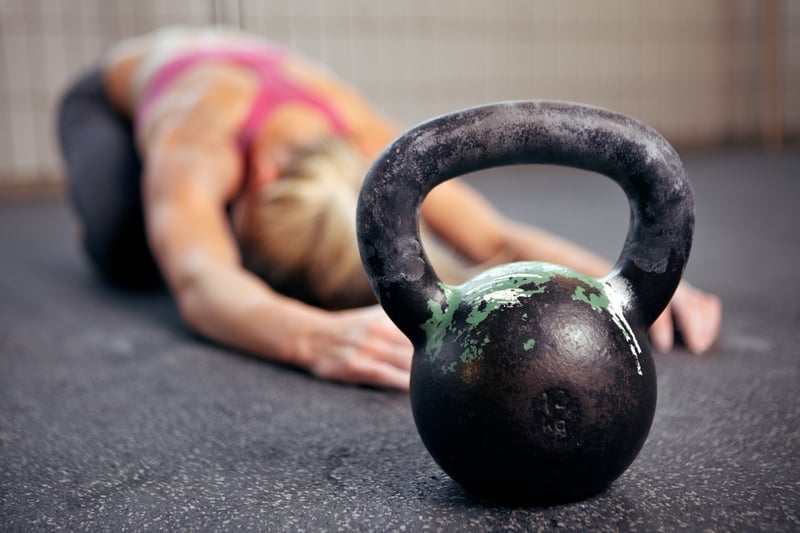Get a Full Body Kettlebell Workout in Under 20 Minutes

Didn’t think it was possible to do a full body kettlebell workout in under 20 minutes? It turns out, not only is it possible, but a kettlebell workout can provide comprehensive fitness benefits you may not otherwise realize with more mainstream equipment.
What Is a Kettlebell?
The term “kettlebell” gets thrown around quite a bit, but that doesn’t mean everyone knows what kettlebells are and how (and why) to include them in their workouts.
There’s nothing sexy in particular about a kettlebell, nor do they have any magical powers. Kettlebells date back to the 1700s. A typically drab metal ball with an attached forged handle, the original kettlebells were designed to use as a tool in weighing crops. Originally utilitarian in nature, with an offset center of gravity, the kettlebell soon garnered the interest of fitness enthusiasts because of its multi-faceted fitness potential for both muscle building and cardiovascular enhancement.
These days, it’s not uncommon to see kettlebells in virtually every type of fitness facility and included as part of many mainstream workout plans.
What are the Benefits of Kettlebell Workouts
1. They work your entire body—grabbing and holding onto a kettlebell engages more than just the muscles in your arms. You also engage the very important stabilizer muscles in your core which, out of necessity, balance your body as you hold and move the weight. As you move the kettlebell, you also work various other muscles such as those in the back, shoulders, arms, legs, butt, and more.
2. They build muscle and burn fat—the fact that kettlebell workouts can be both aerobic and anerobic make them gems in their class. If you’re going for efficiency, by all means, you should employ a kettlebell workout. You’ll build muscle by virtue of lifting the weight of the kettlebell repeatedly, and you’ll burn fat because of the quick pace involved in a kettlebell workout.
3. They work more muscles in less time—using kettlebells, by definition, requires you to engage a number of muscles to perform each movement. Extra muscle recruitment means extra calorie burning and a faster metabolism. That’s why you can perform an intensive, full body kettlebell workout in less time.

Try This Full Body Kettlebell Workout
Are you ready to try your hand at this full body kettlebell workout? Start with the lightest kettlebells you can find until you can master your form. Then, progress to more weight from there as you become more comfortable with “the swing of things.” Repeat each of these exercise for 10 repetitions.
1. Russian Swing—begin by standing with your feet a little wider than hip-width apart. Grasp the kettlebell handle with both hands, palms facing you. Keep your knees slightly bent as you swing the kettlebell backwards through your legs while keeping your arms straight. As the kettlebell moves forward and upward, thrust your hips forward forcefully to generate power. Keep your glutes and your core tight throughout the movement. Once your arms are parallel to the ground, pause, and then allow the weight to return downward, once again swinging the kettlebell back through your legs before you begin the assent again. Remember to control the downward motion slightly so you feel a little resistance.
2. Goblet squat—begin by standing up straight and holding the kettlebell in front of you at chest height with both hands. Keep your elbows pinned to your sides, not allowing them to float outwards. Place your feet wider than hip-width and point your toes out to each side. Next, squat down by pushing your hips backwards and bending your knees (while keeping your back straight) until your thighs are parallel to the ground. Your knees should track outward over your toes as you squat down. Drive upward by pushing through your heels and thrust your hips forward as you stand to complete one set. (The main muscles worked are in the legs, glutes, and core.)
3. Turkish half get-up—this exercise involves using your core and arms to raise your body. Begin by lying on the ground, on your back, with your legs out straight. Grasp a kettlebell with your right hand and extend your arm straight upward. Once your arm is straight, bend your left knee and hoist your torso upwards. You can use your left arm to assist. Once you’re fully upright, slowly lower yourself back to the start and repeat on the opposite side (this is a full body kettlebell workout, utilizing mutiple muscle groups at the same time).
4. Two-arm press—lie on your back with a kettlebell in each hand and press the kettlebells upward until they touch each other over your chest, then slowly lower back toward your chest without resting. Push back up repeatedly for a set of ten repetitions before stopping. (The main muscles worked are the chest muscles and triceps.)
5. Russian twist—begin on the floor, seated with your legs bent and your feet flat on the ground. They should be about hip-distance apart. Hold the kettlebell with both hands near your chest, and then lean backward so your torso is at a 45-degree angle. Rotate your torso from left to right by twisting at the waist and swinging the kettlebell across your body. Move your knees to the left as you twist your arms and shoulders to the right. Repeat on the opposite side to perform one full repetition. (The main muscles worked are in the core.)
6. Single-arm swing—this is very similar to the two-handed Russian swing, except you’re swinging the kettlebell upward with only one arm at a time. You can also swing your other arm upward as well to help drive momentum if that feels good to you. Once your arm reaches floor height again (at the bottom of the movement) alternate your hands while the kettlebell is between your legs. Burst forward and upward again by thrusting your hips forward, this time with the alternate arm. (The main muscles worked are in the arms and core.)
7. Lunge press—begin by standing straight while holding a kettlebell in front of your chest with two hands. Your arms should be bent with your palms facing each other. Lunge a giant step forward with one leg while raising the kettlebell overhead with both arms. Push off through the heel to return to standing while bringing the kettlebell back to your chest. (The main muscles worked include those in the legs, glutes, arms, and, of course, core.)
8. Two-arm row—stand with your feet about hip-width apart and slightly bend the knees. Next, bend over to grab a kettlebell in each hand. Stand up straight and lift them upwards and pull them toward your stomach and chest, keeping your elbows close to your body. Your back should remain straight. Lower the weights and repeat. (The main muscles worked are those in the shoulders and upper back.)
9. Power plank with row—begin in a plank position, but instead of your hands being flat on the ground, you’ll be grasping two kettlebell handles. While holding this position, lift one kettlebell up so it reaches hip height while keeping your elbow tucked in. Lower the kettlebell back down and repeat on the opposite side. (The main muscles worked are in the shoulders, upper back, and core.)






